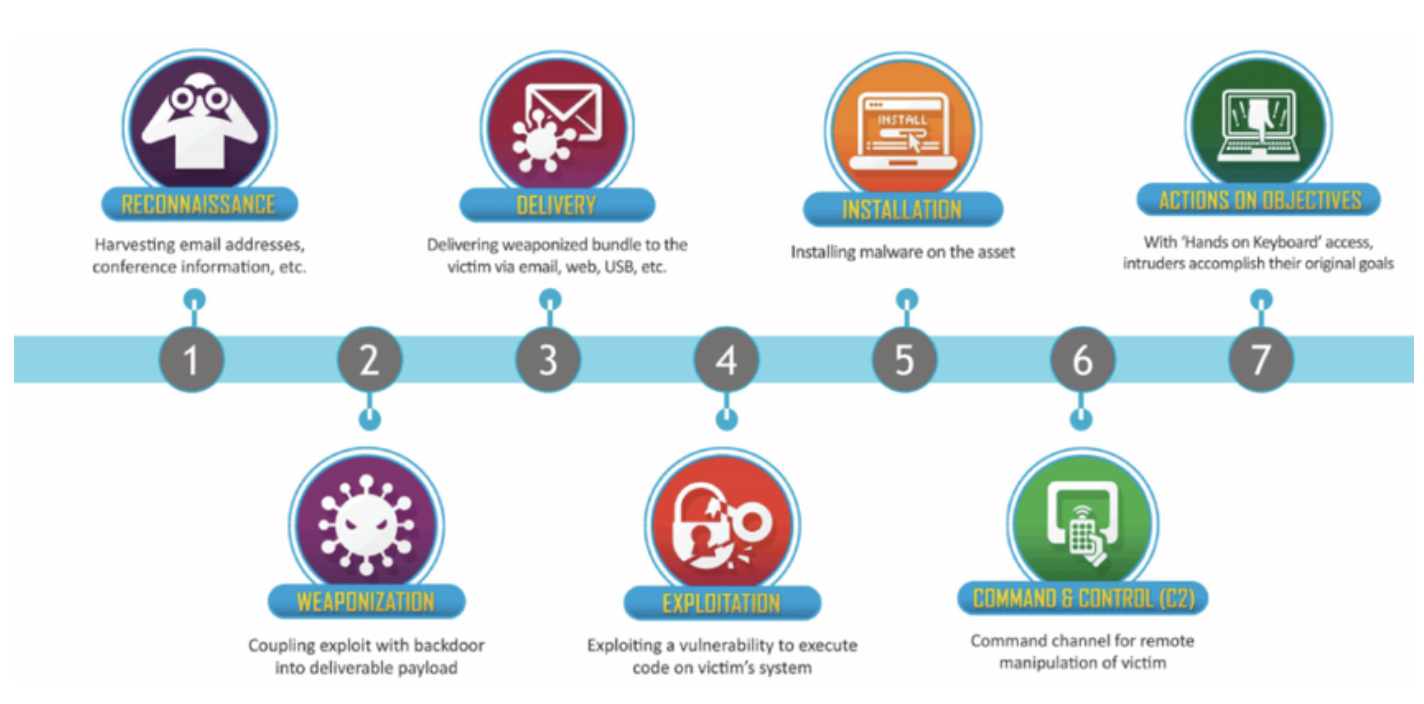Tech Insights & Cyber News
Stay Ahead of the Game
Stay Up-to-Date with the Latest Cyber News and Insights
Stay informed and ahead of the curve with our Cyber Insights page, where you can find thought-provoking blogs and articles on the latest developments in the world of cybersecurity. From new threats to innovative solutions, our expert authors bring you up-to-date information and analysis to help you safeguard your organization in an ever-changing landscape.
Insights & Cyber News

Cyber Kill Chain: Understanding the Stages of Cyber Attack | HartStrand
As cyber threats continue to evolve and become more sophisticated, it is essential for organizations to understand the stages of a cyber attack. By understanding these stages, organizations can develop effective strategies to prevent or mitigate the impact of cyber attacks. One popular framework used to describe these stages is the Cyber Kill Chain, which was developed by Lockheed Martin. In this article, we will explain the Cyber Kill Chain and how it can help organizations protect against cyber threats.

What is the Cyber Kill Chain?
The Cyber Kill Chain is a framework that describes the stages of a cyber attack. It was originally developed by Lockheed Martin and is widely used by security professionals to analyze and prevent cyber attacks. The framework is based on the idea that a cyber attack is a multi-stage process that involves several steps, each of which provides an opportunity for the attacker to be detected and stopped.
The stages of the Cyber Kill Chain are as follows:
Reconnaissance: In this stage, the attacker gathers information about the target organization, such as its network topology, system architecture, and vulnerabilities.
Weaponization: In this stage, the attacker creates a malware payload and prepares it for delivery.
Delivery: In this stage, the attacker delivers the malware payload to the target system, usually through email, social engineering, or exploit kits.
Exploitation: In this stage, the malware payload is executed on the target system, allowing the attacker to gain a foothold in the system and establish persistence.
Installation: In this stage, the attacker installs additional tools and utilities to maintain access to the system and gather data.
Command and Control: In this stage, the attacker establishes a command and control channel to communicate with the compromised system and issue commands.
Actions on Objectives: In this stage, the attacker achieves their ultimate objective, which could be data exfiltration, destruction, or extortion.
By understanding the stages of the Cyber Kill Chain, organizations can develop effective strategies to prevent or mitigate the impact of cyber attacks. Each stage provides an opportunity for detection and prevention, and by focusing on each stage individually, organizations can reduce their overall risk of a successful cyber attack.
How to Use the Cyber Kill Chain to Protect Against Cyber Threats
To use the Cyber Kill Chain to protect against cyber threats, organizations should focus on the following:
Threat Intelligence: Organizations should gather threat intelligence about the latest cyber threats and attack techniques. This can be done through a variety of sources, including industry reports, security vendor intelligence feeds, and open-source intelligence.
Vulnerability Management: Organizations should identify and remediate vulnerabilities in their systems and applications to reduce the attack surface for potential attackers.
Security Controls: Organizations should implement a variety of security controls, including firewalls, intrusion detection and prevention systems, and endpoint protection, to detect and prevent attacks at each stage of the Cyber Kill Chain.
Incident Response: Organizations should have a well-defined incident response plan that outlines the steps to be taken in the event of a cyber attack. This plan should include procedures for detection, containment, investigation, and recovery.
By focusing on these areas, organizations can develop a comprehensive cybersecurity strategy that is designed to protect against the stages of the Cyber Kill Chain.
Threat Intelligence
The first step in protecting against cyber threats is to gather threat intelligence. Threat intelligence is the process of gathering and analyzing information about the latest cyber threats and attack techniques. This can be done through a variety of sources, including industry reports, security vendor intelligence feeds, and open-source intelligence.
Industry reports provide valuable insights into the latest cyber threats and trends. These reports are typically produced by cybersecurity vendors, research firms, or government agencies, and provide detailed analysis of the latest threats, attack techniques, and vulnerabilities. By studying these reports, organizations can gain a better understanding of the threat landscape and identify potential areas of weakness in their cybersecurity defenses.
Security vendor intelligence feeds are another valuable source of threat intelligence. These feeds provide real-time information about the latest threats and attack techniques, and can be integrated into a variety of security controls, such as firewalls and intrusion detection systems. By using these feeds, organizations can detect and prevent attacks at each stage of the Cyber Kill Chain.
Open-source intelligence is also an important source of threat intelligence. This includes information gathered from public sources, such as social media, forums, and blogs. While this information may not be as comprehensive as industry reports or security vendor feeds, it can provide valuable insights into the tactics and techniques used by attackers.
Vulnerability Management
The second step in protecting against cyber threats is to identify and remediate vulnerabilities in systems and applications. Vulnerability management is the process of identifying, prioritizing, and addressing vulnerabilities to reduce the attack surface for potential attackers.
Vulnerability management should be an ongoing process that includes regular vulnerability scans and patching. Organizations should use automated tools to scan their systems and applications for vulnerabilities, and prioritize these vulnerabilities based on their severity and the risk they pose to the organization. Once vulnerabilities have been identified and prioritized, organizations should develop a plan to remediate them, either through patching or other mitigation strategies.
In addition to regular vulnerability scans, organizations should also perform penetration testing to identify potential weaknesses in their cybersecurity defenses. Penetration testing involves simulating an attack on the organization to identify vulnerabilities that may not be detected by automated tools. By performing regular penetration testing, organizations can identify and address weaknesses in their defenses before they are exploited by attackers.
Security Controls
The third step in protecting against cyber threats is to implement a variety of security controls to detect and prevent attacks at each stage of the Cyber Kill Chain. Security controls include a wide range of technologies, such as firewalls, intrusion detection and prevention systems, and endpoint protection.
Firewalls are a critical component of any cybersecurity strategy, as they can prevent unauthorized access to an organization's network. Firewalls can be configured to block traffic from known malicious IP addresses, prevent access to specific ports and protocols, and block traffic based on specific rules.
Intrusion detection and prevention systems (IDPS) are another important security control. IDPS can detect and prevent attacks at each stage of the Cyber Kill Chain by analyzing network traffic for signs of suspicious activity. IDPS can be configured to detect known attack patterns, as well as anomalous behavior that may indicate a new or unknown threat.
Endpoint protection is also critical for protecting against cyber threats. Endpoint protection includes technologies such as antivirus, host-based intrusion detection and prevention systems, and endpoint detection and response (EDR). These technologies can detect and prevent attacks on individual endpoints, such as desktops, laptops, and mobile devices.
Incident Response
The final step in protecting against cyber threats is to have a well-defined incident response plan that outlines the steps to be taken in the event of a cyber attack. An incident response plan should include procedures for detection, containment, investigation, and recovery.
Detection involves identifying the presence of a cyber attack and assessing its impact on the organization. This may involve using security controls to detect the attack, as well as reviewing logs and other sources of data to determine the scope and severity of the attack.
Containment involves limiting the impact of the attack by isolating affected systems and preventing further spread of the attack. This may involve disabling network access, quarantining infected systems, or taking other measures to prevent the attacker from gaining further access to the organization's systems and data.
Investigation involves determining the root cause of the attack, identifying the attacker, and collecting evidence for law enforcement and other stakeholders. This may involve conducting forensic analysis on affected systems, reviewing logs and other sources of data, and collaborating with outside experts to identify the attacker and their motives.
Recovery involves restoring affected systems and data to their pre-attack state, and taking measures to prevent similar attacks in the future. This may involve restoring data from backups, applying patches and other security updates, and strengthening the organization's cybersecurity defenses.
Conclusion
The Cyber Kill Chain is a valuable framework that can help organizations protect against cyber threats. By understanding the stages of a cyber attack and focusing on each stage individually, organizations can develop effective strategies to prevent or mitigate the impact of cyber attacks. Threat intelligence, vulnerability management, security controls, and incident response are all critical components of a comprehensive cybersecurity strategy. By implementing these measures, organizations can reduce their overall risk of a successful cyber attack and protect their sensitive data and systems from cyber threats.
Organizations that take a proactive approach to cybersecurity and implement the Cyber Kill Chain framework can significantly reduce their risk of a successful cyber attack. By gathering threat intelligence, identifying and remediating vulnerabilities, implementing security controls, and having a well-defined incident response plan, organizations can detect and prevent cyber attacks at each stage of the Cyber Kill Chain.
However, it is important to note that cybersecurity is an ongoing process, and organizations must remain vigilant in their efforts to protect against cyber threats. The threat landscape is constantly evolving, and attackers are becoming more sophisticated in their tactics and techniques. Therefore, organizations must continuously monitor their systems and networks, and adapt their cybersecurity strategies as needed to address emerging threats and vulnerabilities.
In conclusion, by understanding the Cyber Kill Chain and implementing the strategies outlined in this article, organizations can significantly reduce their risk of a successful cyber attack and protect their sensitive data and systems from harm. Learn how you can protect your organization, contact us today!
We are available to assist
24 x 7 x 365.
Call Us at (833) 447-0672
Industries
Banking & Financial Services
Communications
Consumer Products
Utilities
Healthcare
Information Services
Insurance
Manufacturing
Oil & Gas
Media & Entertainment
Retail
Technology & Engineering
Transportation & Logistics
Travel & Hospitality
Engineering
Expertise
Consulting
Solutions On Demand
Privacy Policy | Cookie Policy | Terms and Conditions | UEID: KW1FKQ199HY1 | CAGE: 9C6V1
Copyright (c) 2025 HartStrand ® All Rights Reserved.


